immunology 电子教案
中图版生物必修3第一节《 人体免疫系统》word教案一
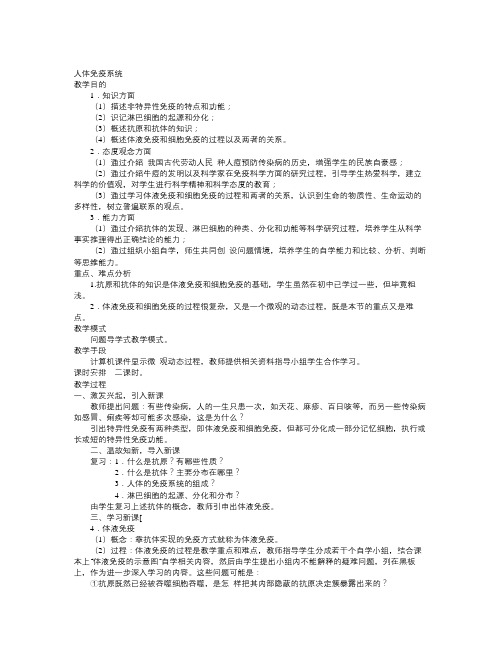
人体免疫系统教学目的1.知识方面(1)描述非特异性免疫的特点和功能;(2)识记淋巴细胞的起源和分化;(3)概述抗原和抗体的知识;(4)概述体液免疫和细胞免疫的过程以及两者的关系。
2.态度观念方面(1)通过介绍我国古代劳动人民种人痘预防传染病的历史,增强学生的民族自豪感;(2)通过介绍牛痘的发明以及科学家在免疫科学方面的研究过程,引导学生热爱科学,建立科学的价值观,对学生进行科学精神和科学态度的教育;(3)通过学习体液免疫和细胞免疫的过程和两者的关系,认识到生命的物质性、生命运动的多样性,树立普遍联系的观点。
3.能力方面(1)通过介绍抗体的发现、淋巴细胞的种类、分化和功能等科学研究过程,培养学生从科学事实推理得出正确结论的能力;(2)通过组织小组自学,师生共同创设问题情境,培养学生的自学能力和比较、分析、判断等思维能力。
重点、难点分析1.抗原和抗体的知识是体液免疫和细胞免疫的基础,学生虽然在初中已学过一些,但毕竟粗浅。
2.体液免疫和细胞免疫的过程很复杂,又是一个微观的动态过程,既是本节的重点又是难点。
教学模式问题导学式教学模式。
教学手段计算机课件显示微观动态过程,教师提供相关资料指导小组学生合作学习。
课时安排二课时。
教学过程一、激发兴起,引入新课教师提出问题:有些传染病,人的一生只患一次,如天花、麻疹、百日咳等,而另一些传染病如感冒、痢疾等却可能多次感染,这是为什么?引出特异性免疫有两种类型,即体液免疫和细胞免疫,但都可分化成一部分记忆细胞,执行或长或短的特异性免疫功能。
二、温故知新,导入新课复习:1.什么是抗原?有哪些性质?2.什么是抗体?主要分布在哪里?3.人体的免疫系统的组成?4.淋巴细胞的起源、分化和分布?由学生复习上述抗体的概念,教师引申出体液免疫。
三、学习新课[4.体液免疫(1)概念:靠抗体实现的免疫方式就称为体液免疫。
(2)过程:体液免疫的过程是教学重点和难点,教师指导学生分成若干个自学小组,结合课本上“体液免疫的示意图”自学相关内容,然后由学生提出小组内不能解释的疑难问题,列在黑板上,作为进一步深入学习的内容。
北师版生物七年级下册第3节 《人体免疫》教案2
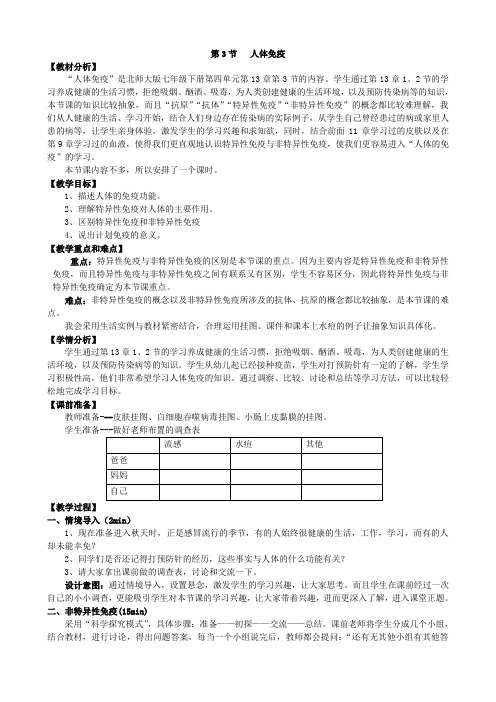
第3节人体免疫【教材分析】“人体免疫”是北师大版七年级下册第四单元第13章第3节的内容。
学生通过第13章1、2节的学习养成健康的生活习惯,拒绝吸烟、酗酒、吸毒,为人类创建健康的生活环境,以及预防传染病等的知识,本节课的知识比较抽象,而且“抗原”“抗体”“特异性免疫”“非特异性免疫”的概念都比较难理解,我们从人健康的生活、学习开始,结合人们身边存在传染病的实际例子,从学生自己曾经患过的病或家里人患的病等,让学生亲身体验,激发学生的学习兴趣和求知欲,同时,结合前面11章学习过的皮肤以及在第9章学习过的血液,使得我们更直观地认识特异性免疫与非特异性免疫,使我们更容易进入“人体的免疫”的学习。
本节课内容不多,所以安排了一个课时。
【教学目标】1、描述人体的免疫功能。
2、理解特异性免疫对人体的主要作用。
3、区别特异性免疫和非特异性免疫4、说出计划免疫的意义。
【教学重点和难点】重点:特异性免疫与非特异性免疫的区别是本节课的重点。
因为主要内容是特异性免疫和非特异性免疫,而且特异性免疫与非特异性免疫之间有联系又有区别,学生不容易区分,因此将特异性免疫与非特异性免疫确定为本节课重点。
难点:非特异性免疫的概念以及非特异性免疫所涉及的抗体、抗原的概念都比较抽象,是本节课的难点。
我会采用生活实例与教材紧密结合,合理运用挂图、课件和课本上水痘的例子让抽象知识具体化。
【学情分析】学生通过第13章1、2节的学习养成健康的生活习惯,拒绝吸烟、酗酒、吸毒,为人类创建健康的生活环境,以及预防传染病等的知识。
学生从幼儿起已经接种疫苗,学生对打预防针有一定的了解,学生学习积极性高,他们非常希望学习人体免疫的知识。
通过调察、比较、讨论和总结等学习方法,可以比较轻松地完成学习目标。
【课前准备】教师准备---皮肤挂图、白细胞吞噬病毒挂图、小肠上皮黏膜的挂图。
学生准备【教学过程】一、情境导入(2min)1、现在准备进入秋天时,正是感冒流行的季节,有的人始终很健康的生活,工作,学习,而有的人却未能幸免?2、同学们是否还记得打预防针的经历,这些事实与人体的什么功能有关?3、请大家拿出课前做的调查表,讨论和交流一下。
医学免疫学英文版教学设计 (2)
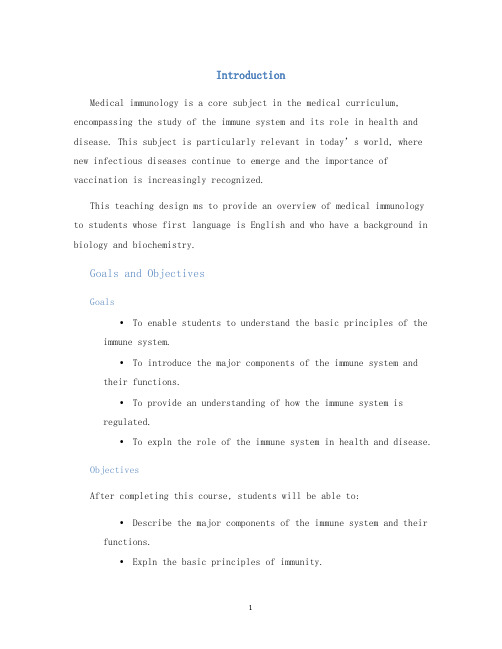
IntroductionMedical immunology is a core subject in the medical curriculum, encompassing the study of the immune system and its role in health and disease. This subject is particularly relevant in today’s world, where new infectious diseases continue to emerge and the importance of vaccination is increasingly recognized.This teaching design ms to provide an overview of medical immunology to students whose first language is English and who have a background in biology and biochemistry.Goals and ObjectivesGoals•To enable students to understand the basic principles of the immune system.•To introduce the major components of the immune system and their functions.•To provide an understanding of how the immune system is regulated.•To expln the role of the immune system in health and disease.ObjectivesAfter completing this course, students will be able to:•Describe the major components of the immune system and their functions.•Expln the basic principles of immunity.•Understand the role of the immune system in preventing and fighting infections.•Describe the mechanisms of immune regulation.•Understand the relationship between the immune system and certn diseases.Course ContentModule 1: Introduction to immunologyIntroduction to immunology, history of immunology, definitions of immunity, antigens, and antibodies.Module 2: Cells and tissues of the immune systemCells and tissues of the immune system, including their structure and function.Module 3: Innate immunityDefinition and components of innate immunity, including the complement system, natural killer cells, and phagocytes.Module 4: Adaptive immunityDefinition and components of adaptive immunity, including T and B cells, major histocompatibility complex (MHC), and antigen presentation.Module 5: Immunological memory and vaccinationImmunological memory, types of immunity, and the principles of vaccination.Module 6: Cytokines and immunoregulationCytokines, their role in the immune system, and the mechanisms of immune regulation.Module 7: Hypersensitivity and autoimmunityTypes of hypersensitivity reactions and autoimmune diseases.Module 8: Immunodeficiency and transplantationTypes of immunodeficiencies and transplantation immunology.Teaching MethodsThe course will be delivered through a combination of lectures, discussions, and interactive activities. In addition, there will be opportunities for students to engage in independent study, including reading textbook chapters, reviewing lecture materials, and participating in online discussions.Lecture formatThe lectures will be approximately 60-90 minutes in length, delivered during weekly classes. Each lecture will be focused on a specific topic related to medical immunology.Discussion formatThe discussion format will consist of group discussions and student-led presentations. In these sessions, students will be encouraged to share their thoughts and opinions on various aspects of medical immunology.Interactive activitiesInteractive activities will be designed to promote engagement and ensure that students understand the course content. These activitieswill include case studies, quizzes, and practical exercises.AssessmentAssessment will be based on a combination of written assignments and exams. The detls of the assessments will be provided in the course syllabus.ConclusionThrough this teaching design, students will be introduced to the fundamental concepts of medical immunology. They will develop a strong understanding of the immune system and its role in health and disease. This knowledge will be highly relevant to their future studies in the medical field and will prepare them to become proficient in this important subject.。
2024版年度医学免疫学与微生物学电子教案

医学免疫学与微生物学电子教案contents •免疫学基础•微生物学概述•医学免疫学应用•医学微生物学应用•实验技术与研究方法•学科前沿与未来展望目录01免疫学基础03免疫分子包括抗体、补体、细胞因子等,参与免疫应答和免疫调节过程。
01免疫器官包括骨髓、胸腺、淋巴结、脾脏等,是免疫细胞生成、成熟和定居的场所。
02免疫细胞包括T 淋巴细胞、B 淋巴细胞、自然杀伤细胞等,发挥免疫应答和免疫调节功能。
免疫系统的组成与功能抗原与抗体概述抗原指能刺激机体免疫系统产生特异性免疫应答,并能与相应免疫应答产物在体内或体外发生特异性结合的物质。
抗体指免疫系统在抗原刺激下,由B淋巴细胞或记忆细胞增殖分化成的浆细胞所产生的、可与相应抗原发生特异性结合的免疫球蛋白。
非特异性免疫,对多种病原体有防御作用,包括屏障结构、吞噬作用、炎症反应等。
固有免疫应答适应性免疫应答免疫记忆特异性免疫,针对特定病原体产生免疫应答,包括T 细胞介导的细胞免疫和B 细胞介导的体液免疫。
免疫系统对特定抗原的记忆能力,再次遇到相同抗原时能快速、高效地产生免疫应答。
030201免疫应答过程及机制免疫系统通过自身调节机制维持免疫稳态,包括免疫细胞间的相互作用、细胞因子的调节等。
免疫调节机体对抗原的特异性无应答或低应答状态,有利于维持自身免疫稳定和防止自身免疫病的发生。
免疫耐受病原体通过某些机制逃避免疫系统的攻击,导致感染持续存在或反复发作。
免疫逃逸免疫调节与免疫耐受02微生物学概述微生物的分类与特点分类微生物包括细菌、病毒、真菌、原生动物等,根据形态、结构、代谢方式等特征进行分类。
特点微生物具有体积小、表面积大、生长繁殖迅速、代谢类型多样、适应性强等特点。
微生物的遗传与变异遗传微生物的遗传物质为DNA或RNA,通过基因复制、转录和翻译等过程实现遗传信息的传递。
变异微生物在遗传过程中会发生基因突变、基因重组等变异现象,导致微生物的性状发生改变。
微生物的生长繁殖与培养生长繁殖微生物通过吸收营养物质、合成细胞成分、分裂增殖等过程实现生长繁殖。
医学免疫学MEDICALIMMUNOLOGY教学
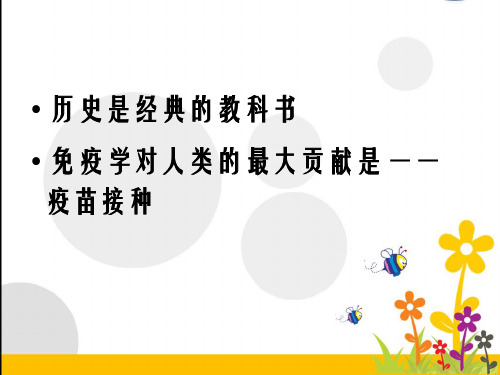
(3) 免疫遗传学研究
➢ MHC(主要组织相容性复合体) ➢ 抗体多样性 ➢ 抗体多样性遗传控制
(genetic control of antibody diversity) • 1978年,Tonegawa:
克隆了Ig的V、C区基因,使免疫学进入 分子免疫学(molecular immunology)
一、经验免疫学阶 段(16-19世纪)
中国古代种痘图 Variolation
人痘苗——中国人 16-17世 纪
1796年,英国人Edward Jenner发明牛痘苗预防天花
(cowpox vaccine)
人们对疫苗的恐惧
宝贝,接种疫苗啦!
二、 科学免疫学时期
(19世纪末-20世纪中叶)
• 人工主动免疫 (Artifical active immunity)
(4)免疫学理论体系的形成
①克隆选择学说 (clonal selection theory)
②免疫耐受机制研究
(research of immune tolerance mechanisms) ③免疫应答机制研究
(research of immune response mechanisms) ④早期的细胞免疫与体液免疫学说
(cellular immunity and humoral immunity theory at early stage) ⑤免疫应答分子机制的阐明 (elucidation of molecular mechanisms of immune response)
(5) 其他进展
➢ 细胞因子(cytokine) ➢ 粘附分子(Adhesion molecules) ➢ 免疫耐受(immune tolerance) ➢ 细胞凋亡(apoptosis) ➢ 抗体工程(antibody technology) ➢ 蛋白质工程 ➢ 转基因动物和基因敲除模型的应用 ➢ 基因表达、基因调控与基因治疗 ➢ 免疫调节
NO1-免疫学概论
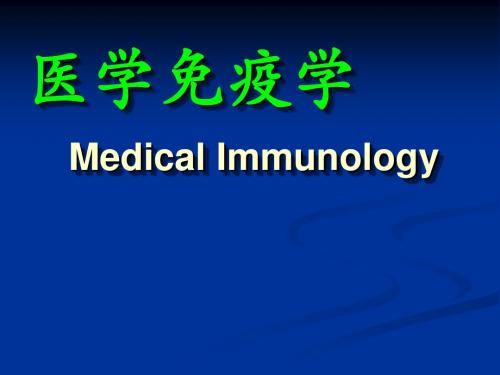
机体对再次感染具有抵抗力
免疫应答不一定都由病原微生物引起. 免疫的功能不仅仅是抗感染
免疫应答的结果并不都对机体有利.
正常情况下有利,异常情况下有害
免疫的概念
现代免疫概念
免疫---------是机体识别和排除抗
原异物,维持机体生理平衡和 稳定的功能
MHC(major histocompatibility complex) TCR( T cell receptor ) BCR( B cell receptor ) Ab( antibody )
功能 参与黏膜局部免疫应答 产生分泌型IgA
淋巴细胞归巢与再循环
淋巴细胞归巢(lymphocyte homing):成熟 淋巴细胞离开中枢免疫器官后,经血液循环趋 向性迁移并定居于外周免疫器官或组织的特定 区域。
淋巴细胞再循环(lymphocyte recirculation):淋巴细胞在血液、淋巴液、 淋巴器官或组织间反复循环的过程。
(非特异性免疫、先天性免疫)
适应性免疫
(特异性免疫 、获得性免疫)
1、固有免疫 (Innate immunity)
是种群长期进化过程中 逐渐形成的,是机体抵御 病原体入侵的第一道防线
固有免疫
先天、可遗传、无异物选择性
组织屏障作用 免疫细胞的非特异性作用
(吞噬细胞的吞噬作用)
体液因子的作用
医学免疫学
免疫学检测技术的基本原 理
免疫学防治
第一章 免疫学概论
“免疫学概论”学习要求
掌握
熟悉
了解
现代免疫 的概念;免 疫系统的 基本功能
固有免疫及 适应性免疫 的概念和特 点
免疫学发 展简史
什么是免疫???
生物专业英语教学案 人体免疫学与感染控制
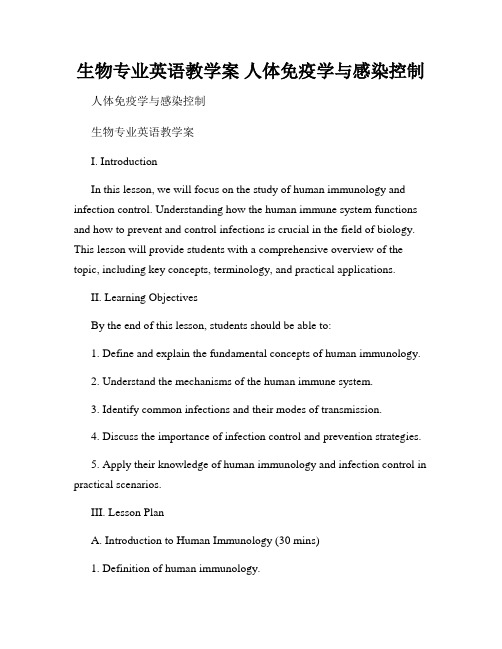
生物专业英语教学案人体免疫学与感染控制人体免疫学与感染控制生物专业英语教学案I. IntroductionIn this lesson, we will focus on the study of human immunology and infection control. Understanding how the human immune system functions and how to prevent and control infections is crucial in the field of biology. This lesson will provide students with a comprehensive overview of the topic, including key concepts, terminology, and practical applications.II. Learning ObjectivesBy the end of this lesson, students should be able to:1. Define and explain the fundamental concepts of human immunology.2. Understand the mechanisms of the human immune system.3. Identify common infections and their modes of transmission.4. Discuss the importance of infection control and prevention strategies.5. Apply their knowledge of human immunology and infection control in practical scenarios.III. Lesson PlanA. Introduction to Human Immunology (30 mins)1. Definition of human immunology.2. Overview of the human immune system.3. Components of the immune system and their functions.4. Immune response and its impact on infection control.B. Mechanisms of the Human Immune System (40 mins)1. Innate immune system and its role in the first line of defense.2. Adaptive immune system and its ability to recognize and respond to specific pathogens.3. Antibodies and their function in immune response.4. Cell-mediated immunity and its role in eliminating infected cells.C. Common Infections and Modes of Transmission (30 mins)1. Overview of common infections, such as viruses, bacteria, and fungi.2. Routes of transmission: airborne, direct contact, vector-borne, etc.3. Case studies of infectious diseases and their transmission pathways.D. Infection Control and Prevention Strategies (40 mins)1. Importance of infection control in healthcare settings.2. Standard precautions and their application in preventing the spread of infections.3. Vaccination and its role in preventing infectious diseases.4. Hand hygiene, personal protective equipment, and other preventive measures.E. Application of Knowledge (20 mins)1. Group discussion and analysis of real-world scenarios.2. Role-playing exercises to demonstrate infection control strategies.3. Q&A session to clarify any remaining questions or concerns.IV. AssessmentTo assess students' understanding of the lesson, the following assessments will be conducted:1. In-class quizzes to test knowledge of human immunology and infection control.2. Group projects to analyze and present infection control strategies for specific scenarios.3. Written assignments to evaluate students' ability to apply their knowledge to practical situations.4. Class participation and engagement during discussions and activities.V. Resources and Materials1. Textbooks and reference materials on human immunology and infection control.2. PowerPoint slides and multimedia presentations.3. Case studies and real-world examples for analysis.4. Handouts and worksheets for exercises and assignments.VI. ConclusionThis teaching plan provides a structured approach to teaching human immunology and infection control in the field of biology. By following this plan, students will gain a thorough understanding of the topic and be able to apply their knowledge in various practical situations. The lesson incorporates a variety of teaching methods to ensure active engagement and understanding among students. It is important to continuously assess students' progress and provide feedback to further enhance their learning experience in this field.。
医学免疫学英文影印版第十版教学设计
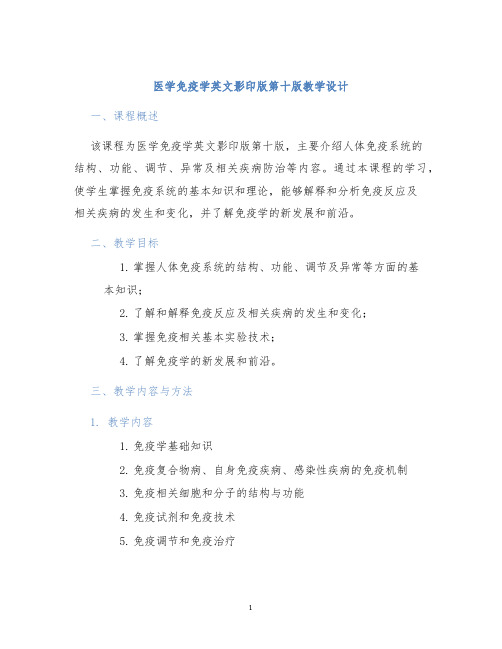
医学免疫学英文影印版第十版教学设计一、课程概述该课程为医学免疫学英文影印版第十版,主要介绍人体免疫系统的结构、功能、调节、异常及相关疾病防治等内容。
通过本课程的学习,使学生掌握免疫系统的基本知识和理论,能够解释和分析免疫反应及相关疾病的发生和变化,并了解免疫学的新发展和前沿。
二、教学目标1.掌握人体免疫系统的结构、功能、调节及异常等方面的基本知识;2.了解和解释免疫反应及相关疾病的发生和变化;3.掌握免疫相关基本实验技术;4.了解免疫学的新发展和前沿。
三、教学内容与方法1. 教学内容1.免疫学基础知识2.免疫复合物病、自身免疫疾病、感染性疾病的免疫机制3.免疫相关细胞和分子的结构与功能4.免疫试剂和免疫技术5.免疫调节和免疫治疗2. 教学方法1.讲授2.讨论3.实验操作4.课件演示四、教学时数安排授课总时数为32学时,具体分配如下:章节课时数第一章免疫学基础知识 4第二章免疫复合物病 4第三章自身免疫疾病 4第四章感染性疾病的免疫机制 4第五章免疫相关细胞和分子的结构与功能8第六章免疫试剂和免疫技术 4第七章免疫调节和免疫治疗 4五、教学评价1. 考核方式1.期中考试(闭卷)占40%;2.期末考试(闭卷)占60%。
2. 教学评价标准1.学生的平时听课、讨论情况和实验记录占10%;2.期中考试成绩占40%;3.期末考试成绩占50%。
六、教材及参考书目1. 教材医学免疫学英文影印版第十版2. 参考书目1.Janeway’s Immunobiology2.Abbas’s Cellular and Molecular Immunology3.Murphy’s Immunobiology4.Roitt’s Essential Immunology七、教学团队本课程教学团队由医学免疫学教研室的专业教师组成,教师具有医学免疫学相关领域的专业知识和丰富的教学经验。
教学团队成员将共同制定本课程的课程大纲,设计并组织实验和课堂教学,为学生提供全面、系统的教育。
电子教案-江苏大学医学技术学院教案.doc

江苏大学医学技术学院教案课程临床免疫学及免疫检验专业班级医学检验02(12)1~4 教师姓名王胜军教师职称副教授年度2005 ~ 2006(I)2005年8月29日讲课内容Introduction, Antigen教学方式Lecture 学时 2教学目的1 The Concept of Immune and Immunology .2 The History and Preface of Immunology.3 The Concept and Character of Antigens; the structure of antigens; the range of antigens.授课提纲及时间分配Chapter 1. IntroductionPart 1 The Concept of Immune and Immunology 20min(1) The Concept of Immune(2) The Functions of Immune(3) The Concept of ImmnuologyPart 2 The History and Preface of Immunology 25min(1)Experience Time of Immunology(2) Forming and Developing Time of Immunology(3) Modern Time of ImmunologyChapter 2. AntigensPart 1 The Concept and Character of Antigens 10minPart 2 The immunogenicity and Specific of Antigens 15minPart 3 The Structure of Antigens 10minPart 4 The range of Antigens 10min难点与重点The Concept of Immune & the Functions of Immune.The Concept and Character of Antigens.The Structure of Antigens新进展The Preface of Cellular and Molecular Immunology教学手段Multimedia参考书临床免疫学和免疫检验,王兰兰主编,人民卫生出版社,2003医学免疫学,吴敏毓主编,中国科技大学出版社,2002Immunology (sixth edition), Roitt, Harcourt Asia Pte Ltd, 2001复习思考题What are the functions of immune system?Describe the differences of T cell epitopes and B cell epitopes.讲课改进意见教研室主任年月日2005年8月31日讲课内容Immunoglobulin (1)教学方式Lecture 学时 2 教学目的1 The Concept of Immunoglobulin and Antibody.2 The Structure of Immunoglobulin.3 The Classes of Immunoglobulin.授课提纲及时间分配Review 5minChapter 3. ImmunoglobulinPart 1 The Concept of Immunoglobulin and Antibody . 10minPart 2 The Structure of Immunoglobulin. 40min(1)The Basic Structure(2) The Functions of Globular Domains(3) The Proteolytic Fragments Part 3 Immunoglobulin Classes and Subclasses. 35minIgGIgMIgAIgEIgD难点与重点Amino Acid Sequences Reveal Variations in Ig Structure.The Characters of Five Major Types of Ig.新进展教学手段Multimedia参考书临床免疫学和免疫检验,王兰兰主编,人民卫生出版社,2003 医学免疫学,吴敏毓主编,中国科技大学出版社,2002Immunology (sixth edition), Roitt, Harcourt Asia Pte Ltd, 2001复习思考题Structural Variants of the Basic Ig Molecule.The Characters of Five Major Types of Ig.讲课改进意见教研室主任年月日2005年9月1日讲课内容Immunoglobulin(2), Complement System教学方式Lecture 学时 3 教学目的1 Immunoglobulin (2)(1) The Genes and Gene Rearrangement of Immunoglobulin.(2) The Function of Immunoglobulin.2 Complement System(1)The component of Complement System.(2)Activation of Complement System(3)Functions of Complement System, Regulation of Complement System授课提纲及时间分配Review 10minChapter 3. Immunoglobulin (2)Part 4 Immunoglobulin Genes. 20min Part 5 The Function of Immunoglobulin. 15min Chapter 4 Complement SystemPart 1 The component of Complement System. 10min Part 2 Activation of Complement System. 35min(1) Classical Pathway(2) Alternative Pathway(3) MBL PathwayPart 3 Functions of Complement System 15min Part 4 Regulation of Complement System 15min Part 5 Complement Receptor 15min难点与重点A Special Mechanism Effects VDJ Recombination.Activation and Regulation of Complement System.新进展Immunoglobulin Gense & Genetic Engineering Antibody.教学手段Multimedia参考书临床免疫学和免疫检验,王兰兰主编,人民卫生出版社,2003医学免疫学,吴敏毓主编,中国科技大学出版社,2002Immunology (sixth edition), Roitt, Harcourt Asia Pte Ltd, 2001复习思考题The Function of Immunoglobulin.The Complement-Mediated Acute Inflammatory Reaction讲课改进意见教研室主任年月日2005年9月5 日讲课内容MHC教学方式Lecture 学时 2教学目的1 The concept of major histocompatibility complex and human leucocyte antigen.2 The gene structure and characters of MHC .3 The HLA molecules structure and cellular distribution.4 The function of HLA.授课提纲及时间分配Review 5minChapter 5. Major histocompatibility complexPart 1 The concept of MHC & HLA. 10minPart 2 The gene structure and characters of MHC . 25min(1) MHC class I genes(2) MHC class II genes(3) The genetic characters of MHCPart 3 The HLA molecules structure and cellular distribution. 20min(1) HLA-A,B,C structure & distribution(2) HLA-DP,DQ,DR structure & distributionPart 4 The HLA molecules function. 20min(1) Antigen processing( Class I & Class II)(2)MHC restriction(3)T cells developmentPart 5 Clinical application 10min难点与重点The Concept of MHC & HLA.The gene of MHC display remarkable polymorphismThe HLA class I & class II processing pathway.MHC restriction新进展教学手段Multimedia参考书临床免疫学和免疫检验,王兰兰主编,人民卫生出版社,2003医学免疫学,吴敏毓主编,中国科技大学出版社,2002Immunology (sixth edition), Roitt, Harcourt Asia Pte Ltd, 2001复习思考题What are the gene polymorphism of MHC?Describe the differences of MHC class I and class II processing pathway. 讲课改进意见教研室主任年月日2005年9月7 日讲课内容immune sysytem (1)教学方式Lecture 学时 2教学目的1 Organs of immune (Central lymphoid organs & Peripheral lymphoid organs)2 Cells of immune (antigen presenting cells, lymphocytes)授课提纲及时间分配Review 5minChapter 6. Immune systemP art 1 Organs of immune . 20min(1)Central lymphoid organs( bone marrow, thymus )(2)Peripheral lymphoid organs( spleen, lymph node, other peripheral lymphoid tissues)(3)Lymphocytes traffic and recirculationPart 2 Cells of immune(1) Antigen presenting cells ( Macrophage , Dendritic cells, B cells) 20min(2) LymphocytesI T lymphocytes . 45minSurface markerSubclassFunctionsDevelopment难点与重点Lymphocytes recirculationT-cell development in thymus新进展T-cells receptor diversity.教学手段Multimedia参考书临床免疫学和免疫检验,王兰兰主编,人民卫生出版社,2003医学免疫学,吴敏毓主编,中国科技大学出版社,2002Immunology (sixth edition), Roitt, Harcourt Asia Pte Ltd, 2001复习思考题Describe the pathway and physiology function of lymphocytes recirculation.Which molecules involved in T lymphocytes and antigen presenting cells interaction?讲课改进意见教研室主任年月日2005年9月8日讲课内容Immune system (2)教学方式Lecture 学时 3 教学目的1 Cells of immune ( lymphocytes )2 CD antigens & adhesion molecules3 Cytokines授课提纲及时间分配Review 10min Chapter 6. Immune systemPart 2 Cells of immune(2) LymphocytesII B lymphocytes . 35min Surface markerSubclassFunctionsDevelopmentIII Natural killer cells 10min Part 3 Molecules of immune(1)CD antigens 15min(2)Adhesion molecules 20min(3) Cytokines 45minI Molecules with multiple functionsII Cytokine familiesIII Cytokines in clinic难点与重点Mechanism of NK cell-mediated killing.Adhesion molecules & leucocyte migrationCytokines act in a network新进展Chemokines and chemokines receptor.教学手段Multimedia参考书临床免疫学和免疫检验,王兰兰主编,人民卫生出版社,2003 医学免疫学,吴敏毓主编,中国科技大学出版社,2002Immunology (sixth edition), Roitt, Harcourt Asia Pte Ltd, 2001复习思考题The differences of killing mechanism in NK cells and CTL.The bipolar Th1/Th2 and clinical disease.讲课改进意见教研室主任年月日2005年9月12日讲课内容Immune response (1)教学方式Lecture 学时 2教学目的1 The concept and stage of immune response.2 T cells mediated immunity3 B cells mediated immunity授课提纲及时间分配Review 10minChapter 7. Immune responsePart 1 The concept and stage of immune response. 20minPart 2 T cells mediated immunity(1) Antigen presentation 15min(2) Activation of T Lymphocytes 20min(3)Effects of T cells mediated immunity 25minI Th1II CTL难点与重点Double recognition and dual signals.T cells-mediated cytotoxicity.新进展教学手段Multimedia参考书临床免疫学和免疫检验,王兰兰主编,人民卫生出版社,2003医学免疫学,吴敏毓主编,中国科技大学出版社,2002Immunology (sixth edition), Roitt, Harcourt Asia Pte Ltd, 2001复习思考题Complex between TCR, MHC and peptideCytotoxicity Mechanism of CTL.Recognition of different forms of antigen by B- and T-cells.讲课改进意见教研室主任年月日2005年9月14日讲课内容Immune response (2) & Immunoregulation教学方式Lecture 学时 2教学目的1 B cells mediated immunity2 Regulation of the immune response by gene, molecules, and cells. 授课提纲及时间分配Review 5min Chapter 7. Immune response(2)Part 3 B cells mediated immunity(1)Activation of B cells by TI-Ag &TD-Ag 15min(2) Activation and differentiation of B cells in the germinal center 10min(3) Antibody response in vivo 15minChapter 8. ImmunregulationPart 1 Genetic control of immune response 5minPart 2 Regulation by antigen and antibody 10min Part 3 Regulation by immune cells 25minPart 4 Neuroendocrine modulation of immune response 5min难点与重点Differentiation of B cells in the germinal centerAffinity maturation and class switchingRegulation by immune cells新进展The role of regulatory T cells in immunoregulation教学手段Multimedia参考书临床免疫学和免疫检验,王兰兰主编,人民卫生出版社,2003医学免疫学,吴敏毓主编,中国科技大学出版社,2002Immunology (sixth edition), Roitt, Harcourt Asia Pte Ltd, 2001复习思考题Recognition of different forms of antigen by B- and T-cells.How to modulate the immune response by lymphocytes?讲课改进意见教研室主任年月日2005年9月19日讲课内容抗原抗体反应,免疫原和抗血清制备教学方式理论学时 2教学目的1熟练掌握抗原抗体反应的机理及特点(反应的特异性、比例性、可逆性、阶段性)和反应类型;了解抗原抗体反应的影响因素(抗原、抗体及反应环境)。
《免疫学导论》双语教学辅助资料(英文版)

《免疫学导论》(于善谦等编,高等教育出版社)双语教学辅助资料Auxiliary Material of Bilingual TeachingforIntroduction to ImmunologyDepartment of ImmunologyCONTENTSCHAPTER ONE INTRODUCTION1-1 Origination and development of Immunology1-2 Essential points of concepts of immunologyCHATPTER TWO ANTIGEN2-1 Basic concept and types of antigen2-2 The molecular base of antigen2-3 The immunological features of antigen2-4 Invasive and infectious antigensCHAPTER THREE ANTIBODIES3-1 Structures and classes of immunoglobulins3-2 The gene of immunoglobulins3-3 Synthesis and secretion of immunoglobulins CHAPTER FOUR COMPLEMENT SYSTEM4-1 Composition and physiochemical properties of complement system4-2 Complement activation4-3 The control of complement reaction andbiological effect of complements4-4 Biosynthesis of complement and complement deficiencyCHAPTER FIVE CELLS, TISSUES AND ORGANS OF IMMUNE SYSTEM5-1 The structure and function of organs and lymphoid tissue and organs5-2 The cells in immune systemCHAPTER SIX MAJOR HISTOCOMPA TIBILITY COMPLEX6-1 Structure and function of majorhistocompatibility antigen6-2 Gene structure and genetics of majorhistocompatibilty complex6-3 The Principle and application of detection for MHC CHAPTER SEVEN ANTIGEN-ANTIBODY REACTION AND ITS APPLICA TION7-1 Antibody preparations7-2 The principle of antigen-antibody reaction7-3 Common techniques in immuno-analysisCHAPTER EITHT CELL MEDIATED IMMUNE RESPONSE8-1 Basic concept for immune response8-2 The basic process of immune response,8-3 Cell apoptosis and immunityCHAPTER NINE IMMUNE REGULATION9-1 The regulation of antigen and antibody in the immune response9-2 The regulatory effect of immune cells in immune response9-3 Interleukins and Immune regulation9-4 Immune toleranceCHAPTER TEN HYPERSENSITIVITY10-1 Type I Hypersensitivity10-2 Type II Hypersensitivity (CytotoxicHypersensitivity)10-3 Type III Hypersensitivity ( Immune complex hypersensitivity)10-4 Type IV Hypersensitivity (Delayed Type Hypersensitivity)CHAPTER ELEVEN ABNORMAL IMMUNERESPONSES11-1 Auto immune response11-2 Transplantation Immunology11-3 Anti-tumor Immunology11-4 Immunologic deficiencyCHAPTER TWELVE THE EVOLUTION OFIMMUNE SYSTEM12-1 The immunity of invertebrate animals12-2 The immune evolution of vertebrate animalsCHAPTER ONE INTRODUCTION(绪言)1-1 Origination and development of Immunology1-1-1 Infection and immunity ofdiseases1-1-2 Foundation and development of the discipline of Immunology1-1-3 Recent development ofImmunology 1-2 Essential points of concepts of immunology1-2-1 Innate immunity and acquired immunity1-2-2 Immune response1-2-3 Immunology and practicallyapplications1-2-4 Branches of Immunology and their developmentThe term “IMMUNITY”, originally, and might still be considered by people, means the ability of host to resistance to infectious disease. However, the modern concept of immunity is conferring the host the specific function to recognize and neutralizeand/or eliminate foreign materials or substances (biological or non-biological, and even sometime self tissue components) to maintain the homeostasis of host internal environment.Immunity includes innate immunity and acquired immunity, the former is inherent, very quick, and non-specific respond to invasive pathogens; whereas the latter is acquired and adapted after birth of host, and induced specific respond to foreign material (infectious or noninfectious).The Immunology is a study to focusing on how of host to recognition of self and non-self, and how of the response to foreign material (Antigen) and1-1 Origination and development of Immunology1-1-1 Infection of and immunity to diseasesFetal epidemic disease, smallpox (variola), dead rate by smallpox 30-40%; killed millions of peoples in this globe before nineteenth century.From Song Dynasty Chinese doctor invested a technique called variolation (人痘接种法) to prevent children from smallpox1798, an young doctor in England, Jenner, created a new method, vaccination (牛痘接种法), to prevent the children from smallpox, and finally, by using this very effective technique, the smallpox, a fatal epidemic disease has been eliminated in the world, stated by the WHO in 1979.orbility smallpox, measles(, thypho, cholera (伤寒),anthrax鼠疫鼠疫,疟疾malaria1-1-2 Foundation and development of the discipline of Immunology(1)1. Foundation of immunology(1) Louis Pasteur, was a famous biochemist in France in 19th century, contributed his lots of effort to immunization to prevent animal and human from several serious diseases (cholera霍乱, anthrax炭疽, rabies (狂犬病)---vaccination---active immunization(2). Development of experimental immunology1-1-3 Recent development of I mmunology(1). Humoral immunology,(2). Cellular immunology1-2 Essential points of concepts of immunology1-2-1 Innate immunity and acquired immunity1-2-2 immune response1-2-3 Immunology and practically applications1-2-4 Branches of Immunology and their developmentBasic concept or definition for the term “IMMUNITY”, originally, and usually still be considered by common people, means the ability of host to resistance to infectious disease. However, at present, the modern concept of immunity, is conferring the host specific functions to recognize and final neutralize and/or eliminate foreign materials or substances (biological or non-biological, and even sometime self) to maintain the homeostasis of host internal environment.Immunity include innate immunity and acquired immunity, the former is inherent, very quick, and non-specific respond to invasive pathogens; whereas the latter is acquired and adapted after birth of host, and induced specific respond to foreign material (infectious or noninfectious).The Immunology is a study to focusing on how of host to recognition of self andnon-self, and how of the response to foreign material (Antigen) and1-1 Origination and development of Immunology1-1-1 Infection of and immunity to diseasesFetal epidemic disease, smallpox (variola), dead rate by smallpox 30-40%;From Song Dynasty Chinese doctor invested a technique called variolation (人痘接种法) to prevent children from smallpox1798, an young doctor in England, Jenner, created a new method, vaccination (牛痘接种法), to prevent the children from smallpox, and finally, by using this very effective technique, the smallpox, a fatal epidemic disease has been eliminated in the world, stated by the WHO in 1979.orbility smallpox, measles(, thypho, cholera (伤寒)霍乱,anthrax炭疽鼠疫鼠疫,疟疾malaria1-1-2 Foundation and development of the discipline of Immunology1-1-3 Recent development of Immunology1-2 Essential points of concepts of immunology1-2-1 Innate immunity and acquired immunity1-2-2 immune response1-2-3 Immunology and practically applications1-2-4 Branches of Immunology and their developmentCHATPTER TWO ANTIGEN(抗原)2-1 Basic concept and types of antigen 2-1-1 antigen and immunogen2-1-2 classes/types of antigen2-2 The molecular base of antigen2-2-1 chemical features of antigen2-2-2 antigen determinants2-3 The immunological features ofantigen2-3-1 The exogenicity of antigen2-3-2 The relation of immunogenecityto individual and immunizationmanner2-3-3 The specificity of antigen andimmuno-predominance ofantigen2-3-4 The immunologic feature ofhapten2-4 Invasive and infectious antigens2-4-1 Bacteria2-4-2 Fungi2-4-3 virus2-1 Basic concept and types of antigen 2-1-1 antigen and immunogen2-1-2 classes/types of antigen2-2 The molecular base of antigen 2-2-1 chemical features of antigen2-2-2 antigen determinants2-3 The immunological features of antigen2-3-1 The exogenicity of antigen2-3-2 The relation of immunogenecity to individual and immunization manner 2-3-3 The specificity of antigen and immuno-predominance of antigen2-3-4 The immunologic feature of hapten2-4 Invasive and infectious antigens2-4-1 Bacteria2-4-2 Fungi2-4-3 VirusCHAPTER THREE ANTIBODIES(抗体)3-1 Structures and classes ofImmunoglobulins3-1-1 The basic structure of antibodies 3-1-2 Classes and types ofimmunoglobulins3-2 The gene of immunoglobulins3-2-1 The gene structures ofimmunoglobulins3-2-2 Rearrangement and expressionof immunoglobulin genes3-2-3 The diversity ofimmunoglobulin genes3-3 Synthesis and secretion ofimmunoglobulin3-3-1 Humoral immune response and the production of antibodies3-3-2 Expression, assemble andsecretion of immunoglobulin3-1 Structures and classes of Immunoglobulins3-1-1 The basic structure of antibodies3-1-2 Classes and types of immunoglobulins3-2 The gene of immunoglobulins3-2-1 The gene structures of immunoglobulins3-2-2 Rearrangement and expression of immunoglobulin genes3-2-3 The diversity of immunoglobulin genes3-3 Synthesis and secretion of immunoglobulin3-3-1 Humoral immune response and the production of antibodies 3-3-2 Expression, assemble and secretion of immunoglobulinCHAPTER FOUR COMPLEMENT SYSTEM(补体系统)4-1 Composition and physiochemical properties of complement system 4-1-1 Nomenclature of complementcomponents4-1-2 The physiochemical properties of complement components4-2 Complement activation4-2-1 The Classical pathway ofcomplement activation4-2-2 The lectin pathway ofcomplement activation4-2-3 The alternative pathway ofcomplement activation.4-2-4 Membrane lysing complexformation in late phase ofcomplement activation4-2-5 Comparison of three pathwaysin complement activation4-3 The control of complementreaction and biological effect ofcomplements4-3-1 Regulating protein ofcomplement activation in serum 4-3-2 Regulate protein on the surface of cell membrane4-3-3 Complement receptors4-3-4 The biological function ofcomplement protein4-4 Biosynthesis of complement and complement deficiency4-4-1 The gene of complements4-4-2 The biosynthesis of complement 4-4-3 Complement deficiency andcomplement deficient diseases4-1 Composition and physiochemical properties of complement system4-1-1 Nomenclature of complement components4-1-2 The physiochemical properties of complement components4-2 Complement activation4-2-1 The Classical pathway of complement activation4-2-2 The lectin pathway of complement activation4-2-3 The alternative pathway of complement activation.4-2-4 Membrane lysing complex formation in late phase of complement activation4-2-5 Comparison of three pathways in complement activation4-3 The control of complement reaction and biological effect of complements 4-3-1 Regulating protein of complement activation in serum4-3-2 Regulate protein on the surface of cell membrane4-3-3 Complement receptors4-3-4 The biological function of complement protein4-4 Biosynthesis of complement and complement deficiency4-4-1 The gene of complements4-4-2 The biosynthesis of complement4-4-3 Complement deficiency and complement deficient diseasesCHAPTER FIVE CELLS, TISSUES AND ORGANS OF IMMUNE SYSTEM(免疫系统的细胞、组织和器官)5-1 The structure and functions oforgans and lymphoid tissue andorgans5-1-1 The composition and function of primary lymphoid tissues andorgans5-1-2 The composition and function of secondary lymphoid tissues andorgans5-1-3 Lymphocyte re-circulation 5-2 The cells in immune system5-2-1 B cells5-2-2 T cells5-2-3 Natural killer cells and natural suppressor cells5-2-4 phagocytes, granulocytes and mast cells5-2-5 Langerhans cells and dendritic cells5-1 The structure and function of organs and lymphoid tissue and organs 5-1-1 The composition and function of primary lymphoid tissues and organs5-1-2 The composition and function of secondary lymphoid tissues and organs5-1-3 Lymphocyte re-circulation5-2 The cells in immune system5-2-1 B cells5-2-2 T cells5-2-3 Natural killer cells and natural suppressor cells 5-2-4 phagocytes, granulocytes and mast cells5-2-5 Langerhans cells and dendritic cellsCHAPTER SIX MAJOR HISTOCOMPATIBILITY COMPLEX(主要组织相容性复合体)6-1 Structure and function of majorhistocompatibility antigen6-1-1 Class I major histocompatibility complex (MHC-I) molecules6-1-2 Class II major histocompatibility complex (MHC-II) molecules6-1-3 The structural base ofcombination of peptide andMHC molecule6-2 Gene structure and genetics ofmajor histocompatibilitycomplex6-2-1 Inheritance and polymorphismof MHC6-2-2 The gene structure of mouseMHC(H-2)6-2-3 The gene structure of humanMHC(HLA complex)6-2-4 Discovery and nomenclature of HLA6-3 The Principle and application of detection for MHC6-3-1 Detection of Class I HLAantigen6-3-2 Detection of Class II HLAantigen6-3-3 Phenotyping of HLA gene6-3-4 Applications of detection ofHLA6-1 Structure and function of major histocompatibility antigen6-1-1 Class I major histocompatibility complex (MHC-I) molecules6-1-2 Class II major histocompatibility complex (MHC-II) molecules6-1-3 The structural base of combination of peptide and MHC molecule 6-2 Gene structure and genetics of major histocompatibility complex6-2-1 Inheritance and polymorphism of MHC6-2-2 The gene structure of mouse MHC(H-2)6-2-3 The gene structure of human MHC(HLA complex) 6-2-4 Discovery and nomenclature of HLA6-3 The Principle and application of detection for MHC 6-3-1 Detection of Class I HLA antigen6-3-2 Detection of Class II HLA antigen6-3-3 Phenotyping of HLA gene6-3-4 Applications of detection of HLACHAPTER SEVEN ANTIGEN-ANTIBODY REACTION AND ITS APPLICA TIONS(抗原-抗体反应及其应用)7-1 Antibody preparations7-1-1 Antiserum preparation7-1-2 The preparation of monoclonal antibody7-1-3 The preparation of geneengineering antibody7-1-4 The preparation of catalyticantibody7-2 The principle of antigen-antibody reaction7-2-1 Thermodynamics and dynamics of antigen-antibody reaction 7-2-2 The reaction of antibody to mono valent antigen7-2-3 The reaction of antibody to polyvalent antigen7-3 Common techniques inimmune-analysis7-3-1 immune precipitation7-3-2 immune labeling7-3-3 In site immune-analysis7-3-4 Other applications forantigen-antibody reaction7-1 Antibody preparations7-1-1 Antiserum preparation7-1-2 The preparation of monoclonal antibody7-1-3 The preparation of gene engineering antibody 7-1-4 The preparation of catalytic antibody7-2 The principle of antigen-antibody reaction7-2-1 Thermodynamics and dynamics of antigen-antibody reaction 7-2-2 The reaction of antibody to monovalent antigen7-2-3 The reaction of antibody to polyvalent antigen7-3 Common techniques in immuno-analysis7-3-1 immunoprecipitation7-3-2 immune labeling7-3-3 In site immuno-analysis7-3-4 Other applications for antigen-antibody reactionCHAPTER EITHT CELL MEDIATED IMMUNE RESPONSE(细胞介导的免疫应答)8-1 Basic concept for immuneresponse8-1-1 Non-specificity and specificity of immune response8-1-2 Active immunity, passiveimmunity and adoptiveimmunity8-1-3 Anergy8-2 The basic process of immuneresponse,8-2-1 Antigen presenting cells 8-2-2 T cell activation8-2-3 Exogenous antigen inducedimmune response8-2-4 Endogenous antigen induced immune response8-3 Cell apoptosis and immunity 8-3-1 The features of cell apoptosis 8-3-2 Detection of cell apoptosis8-3-3 Effect of cell apoptosis on the immune response8-1 Basic concept for immune response8-1-1 Non-specificity and specificity of immune response8-1-2 Active immunity, passive immunity and adoptive immunity 8-1-3 Anergy8-2 The basic process of immune response,8-2-1 Antigen presenting cells8-2-2 T cell activation8-2-3 Exogenous antigen induced immune response 8-2-4 Endogenous antigen induced immune response8-3 Cell apoptosis and immunity8-3-1 The features of cell apoptosis8-3-2 Detection of cell apoptosis8-3-3 Effect of cell apoptosis on the immune responseCHAPTER NINE IMMUNE REGULATION(免疫调节)9-1 The regulation of antigen andantibody in the immuneresponse9-1-1 The antigen regulation9-1-2 The antibody regulation9-1-3 The regulatory effect of idiotype - anti-idiotype antibodies9-2 The regulatory effect of immunecells in immune response9-2-1 Immune regulation of T cells9-2-2 Immune regulation of otherimmune cells 9-3 Interleukins and Immuneregulation9-3-1 The catalog of cytokines9-3-2 Interleukins9-3-3 Other cytokines produced by T cells9-4 Immune tolerance9-4-1 Discovery of the immunetolerance9-4-2 Foundation requirement andinduction pathway of immunetolerance9-4-3 The mechanism for Immunetolerance9-1 The regulation of antigen and antibody in the immune response 9-1-1 The antigen regulation9-1-2 The antibody regulation9-1-3 The regulatory effect of idiotype anti-idiotype antibodies9-2 The regulatory effect of immune cells in immune response9-2-1 Immune regulation of T cells9-2-2 Immune regulation of other immune cells9-3 Interleukins and Immunoregulation9-3-1 The catalog of cytokines9-3-2 Interleukins9-3-3 Other cytokines produced by T cells9-4 Immune tolerance9-4-1 Discovery of the immune tolerance9-4-2 Foundation requirement and induction pathway of immune tolerance 9-4-3 The mechanism for Immune toleranceCHAPTER TEN HYPERSENSITIVITY(超敏反应)10-1 Type I Hypersensitivity10-1-1 The pathogenic mechanism of Type I hypersensitivity10-1-2 Allergen in Type IHypersensitivity10-1-3 IgE and receptor for IgE10-1-4 Common diseases induced by Type I Hypersensitivity10-2 Type II Hypersensitivity(Cytotoxic Hypersensitivity) 10-2-1 Injury mechanism of Type IIHypersensitivity10-2-2 Type II Hypersensitivity anddiseases 10-3 Type III Hypersensitivity( Immune complexhypersensitivity)10-3-1. The pathogenic causes of TypeIII hypersensitivity10-3-2 Common immune complexdiseases10-4 Type IV Hypersensitivity(Delayed Type Hypersensitivity) 10-4-1 Delayed Type Hypersensitivity 10-4-2 Intercellular reaction in delayed type hypersensitivity10-4-3 Common Type IVhypersensitivity diseases10-1 Type I Hypersensitivity10-1-1 The pathogenic mechanism of Type I hypersensitivity 10-1-2 Allergen in Type I Hypersensitivity10-1-3 IgE and receptor for IgE10-1-4 Common diseases induced by Type I Hypersensitivity10-2 Type II Hypersensitivity (Cytotoxic Hypersensitivity) 10-2-1 Injury mechanism of Type II Hypersensitivity10-2-2 Type II Hypersensitivity and diseases10-3 Type III Hypersensitivity ( Immune complex hypersensitivity) 10-3-1. The pathogenic causes of Type III hypersensitivity10-3-2 Common immune complex diseases10-4 Type IV Hypersensitivity (Delayed Type Hypersensitivity)10-4-1 Delayed Type Hypersensitivity10-4-2 Intercellular reaction in delayed type hypersensitivity10-4-3 Common Type IV hypersensitivity diseasesCHAPTER ELEVEN ABNORMAL IMMUNE RESPONSES(异常免疫应答)11-1 Auto immune response11-1-1 The causes of auto immuneresponse11-1-2 Autoimmune diseases11-2 Transplantation Immunology 11-2-1 Type of transplantation andimmune response in allograft 11-2-2 Transplant antigen andtransplant immunity11-2-3 The approaches to reducerejection of transplant 11-3 Anti-tumor Immunology11-3-1 Tumor antigen11-3-2 Host immune response totumor11-3-3 Surveillance of and escapefrom immunity to tumor11-3-4 The therapeutic strategies inimmunity to tumor11-4 Immunologic deficiency11-4-1 Inherent immune deficiency 11-4-2 Acquired immunodeficiency syndrome11-1 Auto immune response11-1-1 The causes of auto immune response11-1-2 Autoimmune diseases11-2 Transplantation Immunology11-2-1 Type of transplantation and immune response in allograft 11-2-2 Transplant antigen and transplant immunity11-2-3 The approaches to reduce rejection of transplant11-3 Anti-tumor Immunology11-3-1 Tumor antigen11-3-2 Host immune response to tumor11-3-3 Surveillance of and escape from immunity to tumor 11-3-4 The therapeutic strategies in immunity to tumor11-4 Immunologic deficiency11-4-1 Inherent immune deficiency11-4-2 Acquired immunodeficiency syndromeCHAPTER TWELVE THE EVOLUTION OF IMMUNE SYSTEM(免疫系统的进化)12-1 The immunity of invertebrateanimals12-1-1 Immune cells and theirdefense ability12-1-2 The functions of solubleimmune factors in humoralfluid12-1-3 Transplant immunity and MHC like functions 12-2 The immune evolution ofvertebrate animals12-2-1 The lymphoid tissues inprimary vertebrate animals12-2-2 Comparison of lymphotissueevolution betweeninvertebrates and vertebrates 12-2-3 The evolutions of lymphocytes and immune molecules invertebrates12-1 The immunity of invertebrate animals12-1-1 Immune cells and their defense ability12-1-2 The functions of soluble immune factors in humoral fluid12-1-3 Transplant immunity and MHC like functions12-2 The immune evolution of vertebrate animals12-2-1 The lymphoid tissues in primary vertebrate animals12-2-2 Comparison of lymphotissue evolution between invertebrates and vertebrates 12-2-3 The evolutions of lymphocytes and immune molecules in vertebrates。
医学免疫学英文版教学设计
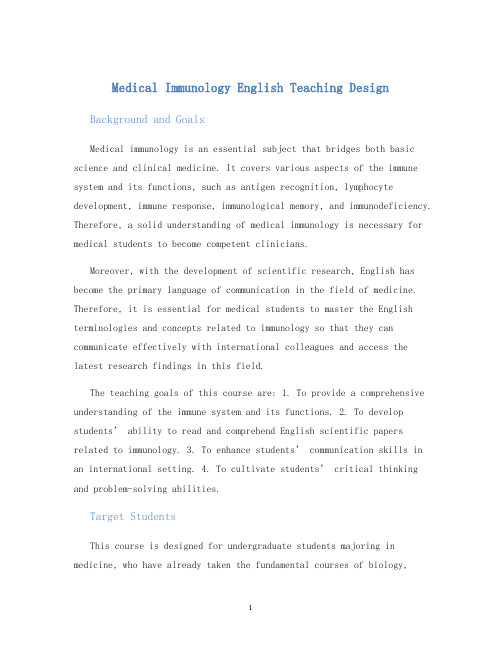
Medical Immunology English Teaching Design Background and GoalsMedical immunology is an essential subject that bridges both basic science and clinical medicine. It covers various aspects of the immune system and its functions, such as antigen recognition, lymphocyte development, immune response, immunological memory, and immunodeficiency. Therefore, a solid understanding of medical immunology is necessary for medical students to become competent clinicians.Moreover, with the development of scientific research, English has become the primary language of communication in the field of medicine. Therefore, it is essential for medical students to master the English terminologies and concepts related to immunology so that they can communicate effectively with international colleagues and access the latest research findings in this field.The teaching goals of this course are: 1. To provide a comprehensive understanding of the immune system and its functions. 2. To develop students’ ability to read and comprehend English scientific papers related to immunology. 3. To enhance students’ communication skills in an international setting. 4. To cultivate students’ critical thinking and problem-solving abilities.Target StudentsThis course is designed for undergraduate students majoring in medicine, who have already taken the fundamental courses of biology,chemistry, and histology. The course is expected to be taken in their third year of study, and around 80 students are enrolled.Teaching Content and MethodsTeaching contentThe content of this course is divided into two mn parts: the immune system and clinical immunology. The immune system part includes the following topics: - Basic concepts of immunity - Innate immunity - Adaptive immunity - Antigen recognition and presentation - T lymphocytes and B lymphocytes - Immunological memory - Immunodeficiency The clinical immunology part includes the following topics: - Hypersensitivity and allergy - Autoimmunity - Transplantation immunology - ImmunotherapyTeaching methodsThe course will be taught in English, and the teaching methods will mnly include: 1. Lectures: The teacher will give lectures on the theoretical knowledge of medical immunology and provide detled explanations of the English scientific terminologies related to the topic. 2. Multimedia presentations: The teacher will use multimediatools such as PowerPoint and videos to present the content vividly and help students better understand the concepts. 3. Group discussions: The teacher will divide the students into small groups and assign a topic related to medical immunology to each group. Students are required to read and comprehend the related scientific literature, summarize key points, and present their findings in front of the class. This activity ms to improve students’ reading and comprehension skills, as well astheir communication abilities. 4. Case studies: The teacher will provide a variety of immunological case studies for students to analyze and discuss. These case studies m to equip students with critical thinking and problem-solving skills. 5. Research presentation: At the end of the course, students will be required to choose a research paper related to immunology, read and comprehend the paper in detl, and present their findings in front of the class. This activity ms to assess students’ mastery of the theoretical knowledge and their ability to read and comprehend English scientific papers.Teaching EvaluationThe teaching evaluation will be based on the following criteria: 1. Attendance: Students are required to attend all the lectures, group discussions, and case studies. 2. Participation: Students are expected to actively participate in the group discussions and case studies. 3. Final exam: The final exam consists of multiple-choice questions and essay questions, which cover all the content of the course. The exam is designed to assess students’ mastery of the theoretical knowledge. 4. Research presentation: The research presentation is designed to evaluate students’ ability to read and c omprehend English scientific papers and their communication skills.ConclusionThe Medical Immunology English Teaching Design ms to provide a comprehensive understanding of the immune system and its functions, develop students’ ability to read and comprehe nd English scientific papers related to immunology, enhance students’ communication skills in an international setting, and cultivate students’ critical thinking andproblem-solving abilities. It is expected that students can master the theoretical knowledge of medical immunology and communicate effectively with international colleagues after completing the course.。
高中生物免疫导课教案

高中生物免疫导课教案教学内容:免疫概念、免疫系统、免疫反应、免疫疾病教学目标:1. 了解免疫的定义和作用;2. 了解免疫系统的组成和功能;3. 了解免疫反应的过程和类型;4. 了解常见的免疫疾病及其预防方法。
教学重点:1. 免疫的概念和作用;2. 免疫系统的组成和功能;3. 免疫反应的类型和过程;4. 常见的免疫疾病及其预防方法。
教学难点:1. 免疫系统的工作原理;2. 免疫反应的细胞和分子基础;3. 免疫疾病的诊断和治疗。
教学方法:讲授结合示范、案例分析、讨论互动教学资源:教材、多媒体设备教学过程:一、导入(5分钟)1. 师生互动,引入免疫的概念和意义;2. 师生共同探讨身体对外界病原体的反应。
二、讲授免疫的概念和作用(15分钟)1. 介绍免疫的定义和作用;2. 分析免疫系统在人体内的重要性。
三、介绍免疫系统的组成和功能(15分钟)1. 分析免疫系统的主要组成部分;2. 探讨免疫系统在人体内的作用机理。
四、讲解免疫反应的类型和过程(20分钟)1. 解释免疫反应的概念及分类;2. 描述免疫反应的过程和机制。
五、分析常见的免疫疾病及其预防方法(15分钟)1. 探讨免疫疾病的种类和症状;2. 强调预防免疫疾病的重要性及预防方法。
六、案例分析及讨论(15分钟)1. 分析一个免疫疾病的病例,让学生思考如何预防和治疗;2. 学生自由发言,讨论免疫疾病防治的各种方法和策略。
七、课堂总结及作业布置(5分钟)1. 总结本节课的主要内容;2. 布置相关作业,加强学生对免疫内容的理解和掌握。
教学反思:教师应根据学生的掌握情况和课堂反馈,及时调整教学方法和内容,确保学生能够全面理解免疫知识,并能够灵活运用到实际生活中。
- 1、下载文档前请自行甄别文档内容的完整性,平台不提供额外的编辑、内容补充、找答案等附加服务。
- 2、"仅部分预览"的文档,不可在线预览部分如存在完整性等问题,可反馈申请退款(可完整预览的文档不适用该条件!)。
- 3、如文档侵犯您的权益,请联系客服反馈,我们会尽快为您处理(人工客服工作时间:9:00-18:30)。
《医学免疫学与微生物学》教学辅导(上)电子教案课程说明一、课程介绍1、课程概况医学免疫学是研究人体免疫系统的组成和功能、免疫应答规律、免疫应答产物,以及有关疾病的免疫学发病机制、诊断和防治的一门生物科学。
微生物学是生物学的一个分支,是研究微生物在一定条件下的形态、结构、生命活动和规律以及与人类、动植物、自然界相互关系等问题的一门科学。
2、学习目的与要求本课程教学目的是使学生掌握微生物的形态结构、生长繁殖、遗传变异,致病性与免疫性,了解微生物与其它生物之间的相互关系,同时掌握机体免疫系统的组成和功能;免疫应答过程及其调节和产生的效应与抗原入侵机体后引起的生理性、病理性免疫应答;以及抗感染免疫、超敏反应、自身免疫和自身免疫性疾病、免疫缺陷、肿瘤免疫、移植免疫等有关方面诸多知识;熟悉免疫学防治原则和检测方法。
要求学生通过具体观察不同的材料,进行各项操作,分析实验结果,训练每个学生掌握研究微生物最基本的操作技能及分析机体免疫功能与疾病发作、合理用药之间关系。
3、课程体系医学免疫学可分为基础免疫学和临床免疫学两个部分。
基础免疫学研究的内容主要包括:①抗原物质;②机体免疫系统的组成和功能;③免疫应答过程及其调节和产生的效应;④免疫学防治原则和检测方法。
临床免疫学是应用免疫学基础理论和基本方法,研究与人体健康或疾病密切相关的各种免疫现象的一个分支学科。
内容主要包括:①抗感染免疫;②超敏反应;③自身免疫和自身免疫性疾病;④免疫缺陷;⑤肿瘤免疫;⑥移植免疫等。
本教材以基础免疫学为主,临床免疫学部分仅介绍超敏反应。
微生物学有许多分支,如普通微生物学、分子微生物学、农业微生物学、工业微生物学、海洋微生物学、石油微生物学、食品微生物学、医学微生物学、兽医微生物学以及微生物生态学、微生物遗传学等。
4、先修课及相关知识介绍医学免疫学与微生物学是药学专业的专业基础课,它是以生物学、生物化学等有关课程的学习和开设为基础的。
近年来,由于科学技术的发展,尤其是生物化学、遗传学、细胞生物学、分子生物学等学科的发展,以及电镜、色谱、免疫标记、分子生物技术的进步,大大促进了医学微生物学的发展。
在微生物形态结构的研究方面已进入超微结构、分子水平的研究。
并在分子水平上探讨基因结构功能、致病的物质基础以及诊断方法,使人类对微生物的活动规律有了更深刻的认识。
免疫标记技术、核酸杂交技术、聚合酶链反应、蛋白印迹技术的应用,使实验室检测方法向着快速、准确、微量、高度灵敏的方向发展。
在预防传染病方面,已有了多种减毒或疫苗、基因工程疫苗等人工自动免疫用生物制剂。
5、教学媒体面授辅导为主,辅以IP课件、电子课件演示、网上辅导答疑、网上实践、实验教学等。
二、教学环节1、课堂教学:面授辅导45学时2、作业及其评改:每月一次,全批全改,有评语、有得分。
3、媒体辅导:IP课件或电子教案辅导,网上辅导,在线答疑,E-mail邮寄问题。
4、问题讨论:小组讨论、课堂讨论或网上交互式讨论。
三、考核说明1、考试形式:闭卷、笔试。
2、卷面分数:卷面分数为100分,占总成绩的80%即80分。
3、平时作业和阶段测试:平时作业1次/月,每次满分25分,一学期共4次,共计100分,占总成绩的5%即5分。
阶段测试安排在期中,满分100分,占总成绩的10%即10分。
4、实验操作:共4次,占总成绩的5%即5分。
5、本科试卷的题型:填空题、选择题、判断题、名词解释、简答题、论述题。
第一篇医学免疫学概述【学习建议】这部分内容概括性地介绍了免疫的概念、免疫的功能、以及免疫系统的组成。
它主要回答了什么是免疫?免疫有哪些功能?免疫功能异常时会出现什么病变?免疫系统有哪些物质组成?同时还简单介绍了免疫学与医学免疫学的研究范畴和免疫学的发展概况。
学习这部分内容,需掌握免疫的基本概念和功能。
熟悉基础免疫学的主要研究内容及免疫系统的组成。
了解免疫学的发展概况。
免疫基本概念免疫防御抗感染免疫缺陷超敏反应免疫自稳清除体内衰亡变性细胞自身免疫病功能免疫监视清除体内突变细胞和病毒感染细胞肿瘤、病毒持续感染免疫器官―中枢:骨髓、胸腺、法氏囊外周:淋巴结、脾、黏膜相关淋巴组织医学免疫免疫系统免疫细胞-造血干细胞、淋巴细胞、抗原提呈细胞、其它免疫细胞学抗原免疫应免疫分子-抗体、补体、细胞因子答免疫学应用【内容提要】一、免疫(一)基本概念(二)功能1.免疫防御2.免疫自稳3.免疫监视二、免疫学与医学免疫学的概念及研究范畴1.免疫学:研究机体免疫系统的组织结构和生理功能的新兴学科。
免疫学起始于微生物学的抗感染免疫,现已广泛渗透到医学的各个领域。
2.医学免疫学:研究人体免疫系统的组成和功能、免疫应答规律、免疫应答对人体有利的和不利的效应和机制、以及利用免疫学原理和技术进行疾病的诊断、治疗和预防的一门学科。
3.医学免疫学研究范畴:(1)基础免疫学:主要研究内容包括四方面:①免疫系统的组成和功能;②抗原物质的种类和特点;③抗原物质和机体免疫系统作用发生免疫应答的过程、规律、调节及其效应;④免疫学技术在疾病的诊断、治疗和预防方面的应用。
(2)临床免疫学:主要研究内容包括抗感染免疫、超敏反应、自身免疫性疾病、免疫缺陷、肿瘤免疫、移植免疫等。
三、免疫学的发展概况【概念简释】1.免疫:指机体对感染有抵抗能力,而不患疫病或传染病。
是机体免疫系统识别并清除外界入侵的“非己”性抗原物质、自身突变和损伤的细胞,保持机体内环境稳定的一种生理功能。
2.免疫防御:机体识别和排斥外来抗原性异物入侵的免疫保护功能。
正常情况下,可抵御外来致病菌的入侵,保护机体免受感染。
异常情况下,免疫防御功能过强,会导致超敏反应;免疫防御功能过弱或缺如则为免疫缺陷,会导致反复发生感染。
3.免疫自稳:机体免疫系统清除体内损伤、衰老、变性的细胞和抗原-抗体复合物,而对自身正常细胞保持免疫耐受,维持内环境稳定的生理功能。
免疫自稳功能异常则导致自身免疫病。
4.免疫监视:机体免疫系统识别和清除体内突变、畸变细胞和病毒感染细胞的生理保护功能。
若此功能失调,有可能导致发生肿瘤和病毒的持续感染。
【重点】一、免疫的基本概念和功能。
二、免疫系统的组成。
三、基础免疫学的研究范畴。
【同步练习】一、填空题(将正确答案填入空内)1.免疫系统由_________、_____________和______________组成。
2.免疫功能包括__________________、_____________和______________。
3.免疫功能失调可发生____________、_______________、_____________和______________。
二、问答题1.什么叫免疫?免疫功能正常和异常时各产生何种效应?2.基础免疫学主要研究内容包括哪些?【参考答案】一、填空题1.免疫器官、免疫细胞、免疫分子2.免疫防御、免疫自稳、免疫监视3.免疫缺陷导致感染、超敏反应、自身免疫病、肿瘤二、问答题1.什么叫免疫?免疫功能正常和异常时各产生何种效应?答:免疫指机体对感染有抵抗能力,而不患疫病或传染病。
是机体免疫系统识别并清除外界入侵的"非己"性抗原物质、自身突变和损伤的细胞,保持机体内环境稳定的一种生理功能。
免疫功能正常时可发挥免疫防御、免疫自稳、免疫监视功能,表现出抗感染、维持内环境稳定、抗肿瘤的生物学效应。
免疫功能异常可分为免疫应答过强、过弱或缺乏,表现为超敏反应、自身免疫病、免疫缺陷导致感染或发生肿瘤等病理效应。
2.基础免疫学主要研究内容包括哪些?答:基础免疫学主要研究内容包括:(1)免疫系统的组成和功能。
(2)抗原物质的种类和特点。
(3)免疫应答过程、规律、调控和效应。
(4)免疫学技术应用。
学习辅导:第一讲一.课程介绍根据高等药学专科学生的培养目标、学制特点和国家教委制定的全国普通高等学校药学专业(专科)主要课程的基本要求,设置医学免疫学与微生物学这门课程。
本课程分为两篇。
第一篇为医学免疫学,主要讲授基础免疫学的内容;第二篇为医学微生物学,包括细菌学、病毒学和其它微生物三部分。
医学免疫学是当今发展最快的学科之一,它已广泛渗透到基础医学和临床医学各领域,并形成了众多的分支和交叉学科。
医学免疫学是研究人体免疫系统的组成、功能、免疫应答的规律和效应、以及有关疾病的发生机理、诊断与防治的科学。
医学微生物学则是研究与医学有关的病原微生物的生物学性状、遗传与变异、致病性与免疫性、实验诊断和防治原则。
二、课程教学的基本要求本课程教学的基本要求分为两部分:在医学免疫学的教学中,要求学生掌握机体免疫系统的组成与功能;免疫应答的生理功能及调节;引起超敏反应的基本机制及防治原则;了解免疫学与疾病的关系及免疫学在医学实践中的应用前景;在医学微生物学的教学中,要求学生掌握细菌、病毒、真菌等病原微生物的形态、结构、生长繁殖、遗传变异等生物学特性,病原微生物的致病性及免疫性,病原微生物感染的检查方法和防治原则,以及消毒、灭菌方法等内容。
三、学习方法指导学员可根据自身的实际情况选择学习方法,但最好能参加学校组织的面授辅导课,并做到课前预习、课后复习。
若实在没有充裕的时间听完全课程,可利用媒体自学、参加网上答疑、网上辅导。
同时,认真完成作业并按时参加实验教学活动;此外,学员还应在每月的作业完成及教师讲评后,结合自身学习情况重新复习所学知识,并对尚不十分清楚的内容整理后,通过网络或电话等通讯方式向老师询问清楚。
第一篇医学免疫学概述一、免疫:指机体识别和清除"异物",维持自身生理功能稳定的机能。
正常--保护机体;异常--破坏机体二、功能:(一)免疫防御1、生理性作用:抵抗病原微生物入侵。
如:完整皮肤可以阻止任何细菌的入侵。
2、病理性作用:破坏机体细胞正常功能。
如:机体对花粉清除中引起的过敏反应。
(二)免疫稳定1、生理性作用:维持机体自身细胞数量及功能的稳定。
例:衰老的红细胞被吞噬细胞清除体外。
2、病理性作用:自身免疫性疾病。
例:由于自身白细胞发生变异,被吞噬细胞清除引起的粒细胞减少症。
(三)免疫监视1、生理性作用:监视癌变细胞的繁殖、增生。
换句话讲:癌细胞常有而癌症不常有。
2、病理性作用:癌细胞大量繁殖。
例:机体免疫力下降时肿瘤即会出现。
第一章免疫器官一、免疫系统:是执行体液免疫和细胞免疫的物质基础,具有识别和排除抗原性异物,维持机体稳定和生理平衡的功能集合体。
二、免疫系统组成:§1 中枢免疫器官一、定义:免疫细胞分化、成熟的场所。
二、组成:§2 外周免疫器官一、定义:免疫细胞定居和繁殖的场所二、组成:脾、淋巴结、粘膜相关淋巴组织三、功能:若细菌、毒素等有害物质进入机体,淋巴结可滤过并清除这些有害物质,具体可表现为防御性局部淋巴结肿大疼痛,如有害物质超出淋巴结防御功能,病原菌可沿淋巴管向全身蔓延。
